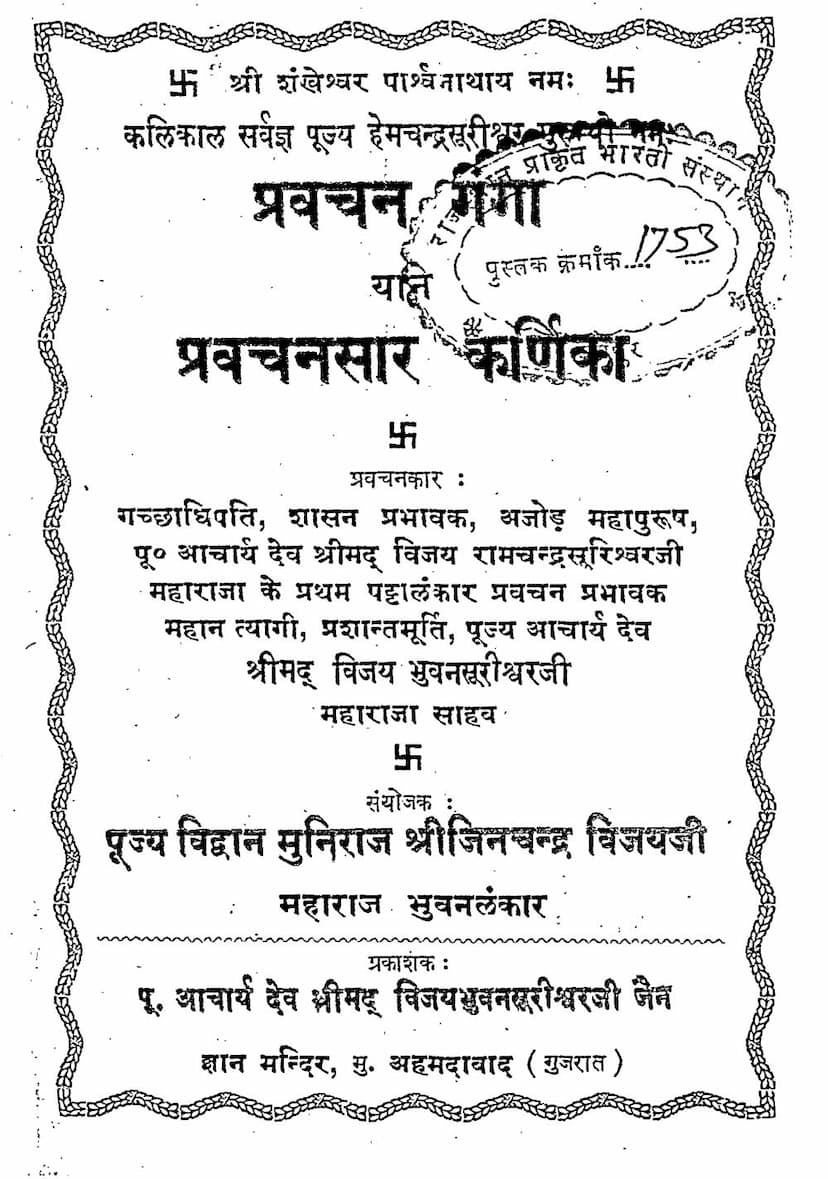Pravachan Ganga Yane Pravachan Sara Karnika
Added to library: September 2, 2025

Summary
Here's a comprehensive summary of the Jain text "Pravachan Ganga yane Pravachan Sara Karnika" by Bhuvansuri, based on the provided pages:
Book Title: Pravachan Ganga yane Pravachan Sara Karnika Author: Bhuvansuri Publisher: Vijaybhuvansuri Gyanmandir, Ahmedabad
Overall Summary:
"Pravachan Ganga yane Pravachan Sara Karnika" is a collection of discourses and teachings delivered by the revered Acharya Dev Shrimad Vijay Bhuvan Surishwarji Maharaja. The book, compiled and organized by Muniraj Shri Jinchandra Vijayji, aims to disseminate profound Jain philosophical and ethical principles in a simple, accessible, and captivating manner. It emphasizes the core tenets of Jainism, including the path to liberation (moksha), the nature of karma, the importance of right faith (samyaktva), righteous conduct (charitra), and right knowledge (gyan). The discourses are interspersed with enlightening stories, analogies, and practical advice for daily life, making them relevant for individuals of all ages and backgrounds.
Key Themes and Teachings:
- The Path to Liberation (Moksha): The central theme is guiding individuals towards liberation from the cycle of birth and death (samsara). This is achieved through a deep understanding and practice of Jain principles.
- Understanding Karma: The text delves into the intricate workings of karma, explaining how actions (karma) lead to bondage and how specific practices like penance (tapasya), righteous conduct, and devotion can lead to the shedding of karma (nirjara). It highlights the difference between movable (chalit) and immovable (achalit) karma and the concept of 'udairana' (bringing karma into effect through one's own efforts).
- The Significance of Samyaktva (Right Faith): Samyaktva is repeatedly emphasized as the foundational element for spiritual progress. It's described as having unshakable faith in the Tirthankaras, omniscient beings (Kevalis), and their teachings (Aagams). The five characteristics of samyaktva are elaborated: equanimity (sham), yearning for liberation (samveg), detachment from the world (nirved), compassion towards all beings (daya), and unwavering faith in the Tirthankaras' words (astikata).
- The Importance of Conduct: The discourses stress the necessity of adhering to the Jain way of life, encompassing vows (vratas), ethical conduct, and mindful living. The text differentiates between those who observe all vows (Mahavratas) like monks (sadhu) and those who observe partial vows like lay followers (shravak/shravika), referring to them as 'dharmadharmi' or 'samkit dikshit.'
- Ethical Living and Daily Practices: The book provides guidance on various aspects of daily life, including:
- Speech: Speaking truthfully, avoiding gossip, and engaging in spiritually uplifting conversations.
- Food: Practicing mindful eating, avoiding unnecessary harm to living beings, and understanding the impact of food choices.
- Relationships: The importance of Dharma in marital choices and the role of righteous conduct in family life.
- Renunciation: The ultimate goal of detachment from worldly possessions and desires (parigraha).
- Devotion: The significance of worshipping the Tirthankaras, gurus, and the Jain scriptures.
- Vigorous Pursuit of Dharma: The need for strong resolve and effort in spiritual practices, even amidst difficulties.
- The Role of the Guru: The profound reverence for the Guru is evident throughout the text. The Guru is portrayed as the spiritual guide who illuminates the path to liberation and helps overcome spiritual obstacles. Muniraj Jinchandra Vijayji's compilation of Acharya Bhuvan Surishwarji's discourses highlights this guru-disciple relationship.
- Illustrative Stories and Examples: The discourses are enriched with numerous captivating stories and parables, such as the story of Queen Madanrekha, Raja Bimbisar, Queen Chellana, and the anecdote of Bunkel the thief. These narratives vividly illustrate the principles being taught and make the complex philosophical concepts relatable.
- Discrimination Between True and False: The text consistently encourages readers to distinguish between genuine spiritual pursuit and superficial practices. It warns against mistaking outward rituals for true inner transformation and emphasizes the importance of understanding the essence of Dharma.
- The Value of Human Birth: The rarity and preciousness of human birth are underscored, as it is considered the only opportune moment for spiritual liberation. The discourses urge readers to make the most of this life by engaging in righteous deeds.
- The Power of Bhavana (Mental Disposition): The text highlights the transformative power of one's intentions and mental state (bhavana). Pure and virtuous bhavana, even without complete external adherence, can lead to profound spiritual outcomes.
- The Importance of Vigilance: From avoiding the slightest harm to living beings to being mindful of one's thoughts, words, and actions, the text consistently promotes vigilance in all aspects of life.
Structure and Style:
- Discourses (Pravachans): The book is structured as a series of discourses, covering a wide range of Jain teachings.
- Accessible Language: Despite dealing with profound philosophical concepts, the language used is designed to be easily understood by a general audience.
- Storytelling: The use of narratives makes the teachings memorable and engaging.
- Compilation and Reverence: The fact that the book is a compilation of a great Acharya's sermons, compiled by a dedicated disciple, adds to its spiritual significance. The explicit expressions of devotion and respect towards the Guru throughout the text are noteworthy.
Target Audience:
The book is intended for all followers of Jainism, particularly those seeking a deeper understanding of their faith, ethical guidelines, and the path to spiritual enlightenment. It serves as a guide for lay followers and spiritual seekers to live a more meaningful and virtuous life, ultimately aiming for liberation.
Overall Impact:
"Pravachan Ganga yane Pravachan Sara Karnika" serves as a spiritual guide, offering practical wisdom and profound insights into Jain philosophy. It aims to inspire readers to cultivate virtues, overcome vices, and dedicate their lives to the pursuit of righteousness and ultimate liberation.